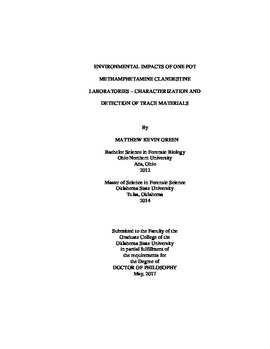| dc.contributor.advisor | Wagner, Jarrad R. | |
| dc.contributor.author | Green, Matthew Kevin | |
| dc.date.accessioned | 2018-03-13T18:15:43Z | |
| dc.date.available | 2018-03-13T18:15:43Z | |
| dc.date.issued | 2017-05 | |
| dc.identifier.uri | https://hdl.handle.net/11244/54531 | |
| dc.description.abstract | The One Pot methamphetamine production method has become the primary method of choice in clandestine drug laboratories across the United States, due to its simplicity and the availability of required materials. While the method is simple, it also generates risk to innocent bystanders within the community from flammability and toxicity hazards. Previous studies have determined the adverse effects of methamphetamine consumption, but there has been little research exploring the health impact of being in close proximity to methamphetamine manufacturing. Despite investigative efforts, clandestine laboratories may not be discovered for an extended period of time, after which, numerous methamphetamine productions will have been completed. As a result, the probability of exposure to toxic substances involved with the One Pot method increase significantly. This study was undertaken to determine and quantify the characteristic products and byproducts of the One Pot methamphetamine method. In addition, studies were conducted to determine the feasibility of detection of methamphetamine clandestine laboratories through monitoring waste water effluents. Methamphetamine was produced by the One Pot method and the methamphetamine hydrochloride product was filtered out. All post-reaction liquids and solids were characterized. In collaboration with local authorities, simulated One Pot methamphetamine waste disposal was performed using a representative lift station. Waste water samples were collected post-distribution to determine a time course detection window and analyzed via solid phase extraction with liquid chromatography-tandem mass spectrometry. Methamphetamine, pseudoephedrine, and ephedrine were all detectable in the waste water. Also, an over-reduced product, characteristic of the One Pot synthesis, CMP [1-(1',4'-cyclohexadienyl)-2-methyl-aminopropane] was detected. As a means to determine the value of CMP as a unique identifier, urine samples that previously tested positive for methamphetamine were analyzed, and only one sample demonstrated positive results for the primary One Pot byproduct. This work identifies the components produced following One Pot methamphetamine production. Additionally, results demonstrate the possibility and potential for analyzing waste water to monitor and detect clandestine One Pot methamphetamine laboratories within communities. | |
| dc.format | application/pdf | |
| dc.language | en_US | |
| dc.rights | Copyright is held by the author who has granted the Oklahoma State University Library the non-exclusive right to share this material in its institutional repository. Contact Digital Library Services at lib-dls@okstate.edu or 405-744-9161 for the permission policy on the use, reproduction or distribution of this material. | |
| dc.title | Environmental impacts of One Pot methamphetamine clandestine laboratories - Characterization and detection of trace materials | |
| dc.contributor.committeeMember | Wallace, David R. | |
| dc.contributor.committeeMember | Payton, Mark E. | |
| dc.contributor.committeeMember | Maxwell, Lara K. | |
| osu.filename | Green_okstate_0664D_15157.pdf | |
| osu.accesstype | Open Access | |
| dc.type.genre | Dissertation | |
| dc.type.material | Text | |
| thesis.degree.discipline | Veterinary Biomedical Sciences | |
| thesis.degree.grantor | Oklahoma State University | |
